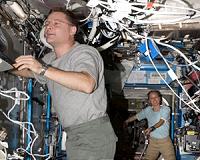 |
Baltimore MD (SPX) May 18, 2011 A highly sensitive and extremely compact instrument for plasma monitoring known as Canary, developed and built by researchers at The Johns Hopkins University Applied Physics Laboratory (APL) in Laurel, Md., lifted off on Monday, May 16 as part of the payload aboard the space shuttle Endeavour and the STS-134 mission to the International Space Station (ISS). Canary, a plasma spectrometer, will investigate the interaction of approaching spacecraft with the background plasma environment around the ISS and disturbances in the ionosphere caused by space vehicles. The device will also provide a better understanding of the origin and impact of plasma irregularities in the Earth's ionosphere, and demonstrate low-cost techniques for monitoring those conditions. Canary is the second Wafer Integrated Plasma Spectrometers (WISPERS) device created by APL; engineers used innovative MicroElectroMechanical (MEMS) technology when designing WISPERS to reduce size and energy consumption while increasing sensitivity. The first WISPERS device was launched last year aboard FalconSat- 5. "Canary and WISPERS will provide on-orbit data for understanding how spacecraft operations affect the natural environment," says Robert Osiander, principal investigator for WISPERS at APL. Canary gathers particles of plasma (an electrically-charged gas) through a hole smaller than the diameter of a human hair; the particles are then sorted according to energy and type by a titanium electrostatic analyzer less than a tenth of an inch thick. By measuring the type and energy levels of plasma around it, Canary can provide warnings of potentially hazardous operating conditions. "Canary will add an important new tool to those we use to understand the near-Earth space environment," says Larry Paxton, a space scientist at APL and member of the Canary team. "Canary will also demonstrate a new, cost-effective approach to supporting our nation's operations in space."
Share This Article With Planet Earth
Related Links Applied Physics Laboratory Station at NASA Station and More at Roscosmos S.P. Korolev RSC Energia Watch NASA TV via Space.TV Space Station News at Space-Travel.Com
 Utah USTAR Professor's Invention Approved by NASA for Long-Term Use Aboard ISS
Utah USTAR Professor's Invention Approved by NASA for Long-Term Use Aboard ISSSalt Lake City UT (SPX) May 18, 2011 After more than 12 months of testing aboard the International Space Station (ISS), an experimental water quality monitoring kit based on technology developed by USTAR professor Marc D. Porter and University of Utah researcher Lorraine M. Siperko was recently certified as operational hardware by NASA. The kit, called the Colorimetric Water Quality Monitoring Kit (CWQMK), uses Colorimetric S ... read more |
|
| The content herein, unless otherwise known to be public domain, are Copyright 1995-2010 - SpaceDaily. AFP and UPI Wire Stories are copyright Agence France-Presse and United Press International. ESA Portal Reports are copyright European Space Agency. All NASA sourced material is public domain. Additional copyrights may apply in whole or part to other bona fide parties. Advertising does not imply endorsement,agreement or approval of any opinions, statements or information provided by SpaceDaily on any Web page published or hosted by SpaceDaily. Privacy Statement |